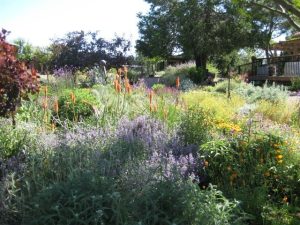A day like this, overcast and rainy, brings to mind a saying from my grandmother. Grandma told all of us grandkids that rain was just the angels crying. That is appropriate for this day when I received the news that Tuolumne County Master Gardeners have lost one of the best of their own.
Vera Strader was a writer extraordinaire. Her words on paper gave clear advice, creating pictures so absolute the smell from the flowers radiated from the page. She was always helpful, always kind (along with having a wicked sense of humor), and will be always missed.
Vera had a background in science which was apparent in her clear, concise writing. But it was as an ardent advocate for native plants and local wildlife that her writing shone. She was enthralled with her adopted location here in the foothills of the Mother Lode. Her passion about her favorite subjects, in her own words, are showcased below, along with photos of her inspiring garden.
“Like most Bay Area Transplants, I was confounded by the challenges of Foothill gardening. But the frustrations of heat, drought, and freeze were overcome by the pleasures of the area’s wildlife. Welcoming wildlife into our yards preserves the richness of the Mother Lode. Right now, is an ideal time to start, whether you have a three-foot balcony or sprawling acreage! Here’s how:
If you have native oaks in your yard, treasure them. They are a wildlife bonanza, providing insects, leaves, bark, and acorns for food, plus spreading branches for shelter and nesting. Our native oaks are well adapted to and require summer drought. Do not water under them during the warm months. Avoid compacting the soil under their limbs.
Some native shrubs provide a double payload—spring flowers AND autumn or winter berries for seed eating birds: Manzanita and Ribes (native gooseberries and currents) bloom first, followed by elderberries, coffee berry, snow berry, and toyon.
Autumn sage and California fuchsia (Zauschneria) delight hummingbirds and other pollinators with blossoms until frost.”
And here are some of Vera’s favorite gardening tips:
“Put Pesticides Out to Pasture. Six out of ten animal species are insects. Non-discriminate insecticide use kills desirable insects along with the troublesome ones. Insects are needed to attract birds, frogs, and pollinators—bees, flower flies, butterflies, hummingbirds, and bats too. Resist the urge to blast insects with a toxic spray. Visit the Integrated Pest Management website for less toxic ways to deal with both insect and weed pests.
Housekeeping Can Hurt Leave leaves and small trimmings lie to form mulch. Replace part of your lawn with some of our many attractive native, drought tolerant, and often deer resistant, plants and trees. A pond or birdbath will draw all sorts of wildlife. Replace fertilizers with homemade or commercial compost or aged barnyard manure.”
We wish Vera a fond farewell with gratitude for her prolific and creative writing, and her many contributions to the Master Gardener program in Tuolumne County.
Contributors are UCCE Master Gardeners Julie Silva, Rebecca Miller-Cripps and Vera Strader herself. She will be sorely missed.



